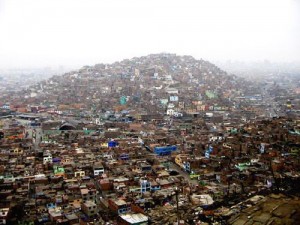 The population of the Republic of Peru for 2014 is estimated at 30,970,408. This is based on the number of births, the number of deaths, the net migration rate, the population growth rate, and the population of 2013. Peru’s population makes up about 0.43% of the world’s total population. Peru is ranked 40th in the world population rankings, behind Afghanistan, but ahead of Venezuela. In July of 2013, the population was estimated at 30,475,144. Thus, since last July, the population has grown by 495,264 people or by a growth rate of 1.63%. The last census was conducted in 2007 and it recorded the population at 28,220,764. Thus, since the last census, the population has grown by 2,749,644 people or by an average annual growth rate of 1.39%. Based on the total land area and the total population of the country, the population density of Peru is estimated at 24.2 people per square kilometer or 62.67 people per square mile.
The population of the Republic of Peru for 2014 is estimated at 30,970,408. This is based on the number of births, the number of deaths, the net migration rate, the population growth rate, and the population of 2013. Peru’s population makes up about 0.43% of the world’s total population. Peru is ranked 40th in the world population rankings, behind Afghanistan, but ahead of Venezuela. In July of 2013, the population was estimated at 30,475,144. Thus, since last July, the population has grown by 495,264 people or by a growth rate of 1.63%. The last census was conducted in 2007 and it recorded the population at 28,220,764. Thus, since the last census, the population has grown by 2,749,644 people or by an average annual growth rate of 1.39%. Based on the total land area and the total population of the country, the population density of Peru is estimated at 24.2 people per square kilometer or 62.67 people per square mile.
Demographics of Peru
The Peruvian population mainly identifies as part of the mestizo ethnic group, which is a group of mixed ancestries. The next largest ethnic group is the Quechua ethnic group. The rest of the population consists of small populations of the Aymara, Amazonian, Mulatto, and White ethnic groups. The official language of the Republic of Peru is Spanish. However, there are approximately 105 individual languages throughout the country. But, about 11 of these languages are considered to be extinct. Lastly, the literacy rate is considered to be about 85%.
Religion in Peru
The majority of the population of the Republic of Peru identifies as Roman Catholic (over 75% of the population). However, there have also been faiths and religions that are based on the worship of the Sun god, the Pachamama, and other aspects of nature. Also, there are other faiths and churches due to the work of missionaries. However, overall, the population of Peru is mainly religious, with very few claiming to be atheist or agnostic.
Sports in Peru
As is the same for many Latin American countries, the main sport of the Republic of Peru is football (American soccer). Football is the sport that is played by people of all social classes, ages, and skill levels. Another popular sport throughout the country is volleyball, especially women’s volleyball. Lastly, bullfighting is a very popular sport, despite attempts by pro-animal lobbies to get rid of bullfighting.
Government of Peru 2014
As established by the Constitution of Peru, the government of Peru is a presidential representative democratic republic under a multi-party system in the executive, legislative, and judicial branches. The executive branch consists of the president, prime minister, and the Council of Ministers. The president is the head of state and the head of government. The president also appoints the prime minister and the Council of Ministers. The current president is Ollanta Humala, a member of the Gana Peru alliance. The prime minister is simply the head of the Council of Ministers. The current prime minister, as of February 24, 2014, is Rene Cornejo, an independent politician in Peru. The legislative branch is a unicameral body called Congress. Congress consists of 130 members that serve five-year terms. While either the executive or legislative branches may propose bills, only Congress can pass the bills. The Gana Peru alliance has the largest number of seats in Congress, followed by Fuerza 2011. Lastly, the judicial branch is independent of both the executive and legislative branches. The head of the judicial branch is the Supreme Court of Peru, which consists of three supreme sectors: civil, criminal, and constitutional and social. The current Chief Justice of the Supreme Court is Francisco Tavara.
Education in Peru 2014
According to the Constitution, education is both compulsory and free for the primary and secondary levels. In fact, depending on a student’s academic ability and financial situation, a student may be able to receive higher education without cost at a public university. Schooling begins in March and lasts until December. Primary schooling begins at age six and lasts for six years, while secondary schooling lasts five years. Students have the option to attend technical schools instead of higher education universities. Bachelor degree programs typically last five years in Peru. Lastly, the Minister of Education, currently Patricia Salas O’Brien oversees and administers the education system in the nation.
As of 2012, the total adult literacy rate in Peru was 89.6% of the adult population. 98% of male youths are literate, while only 96.7% of female youths are literate. About 81.5% of students that start primary school will finish all the years of schooling, but about 97.1% of children enroll in primary school. In 2012, the Programme for International Student Assessment ranked Peru last among 65 countries in mathematics, science, and reading performance. Lastly, the government spends about 2.6% of the annual Gross Domestic Product on education.
Water Supply and Sanitation in Peru 2014
In the 1980s, only 30% of the population had water coverage and 9% had sanitation coverage. Now, the Ministry of Housing, Construction, and Sanitation oversee the supply and sanitation of water. But, there have been large improvements to the water supply and, as of 2011, 95.3% have access to improved drinking water sources, though only 66.1% of those in rural areas have such access. Also, 71.6% of the population has access to improved sanitation facilities, but only 38.4% of those in rural areas have such access. Some current challenges that the country faces include poor service quality, deficient sustainability of the current water systems in place, and a lack of financial resources to improve the water sources. Lastly, in 2006, President Garcia announced his plan to start an investment project to help provide water for everyone.
Health and Health Care in Peru 2014
About 45% of the population is considered to be indigenous. Thus, the health care of the country is very unique because the indigenous use medical practices that their ancestors utilized. Other than that, the Ministry of Health handles about 80% of the public sector’s health services. The Ministry is funded by taxes and loans. Peru has a form of a social security program known as EsSALUD, which is funded by payroll taxes that every employer must pay for their employees. However, overall, Peru spends about 2.7% of its annual Gross Domestic Product on health. There are about 9.2 physicians per 10,000 people and 12.7 nurses and midwives per 10,000 people.
The under-five mortality rate is 18 deaths per 1,000 children under the age of five. The infant mortality rate is 14 deaths per 1,000 infants, while the neonatal mortality rate is 9 deaths per 1,000 infants. The average life expectancy for a Peruvian citizen is 74.5 years with women living longer than men. About 0.4% of the population has been diagnosed with HIV. 37% of deaths result from communicable diseases, 46% result from noncommunicable diseases, and 17% result from injuries. Lastly, as of 2008, 21.7% of women over the age of 20 were obese and 11.1% of men over the age of 20 were obese.
Machu Picchu Peru
7,000 feet above sea level and nestled on a small hilltop between the Andean Mountain Range, the majestic city soars above the Urabamba Valley below. The Incan built structure has been deemed the “Lost Cities”, unknown until its relatively recent discovery in 1911. Archaeologists estimate that approximately 1200 people could have lived in the area, though many theorize it was most likely a retreat for Incan rulers. Due to it’s isolation from the rest of Peru, living in the area full time would require traveling great distances just to reach the nearest village. Machu Picchu is vulnerable to threats from a variety of sources. While natural phenomena like earthquakes and weather systems can play havoc with access, the site also suffers from the pressures of too many tourists. Traveling from Cusco through the Urubamba Valley to Machu Picchu is a journey that emanates ancient history from start to finish. It’s here that active adventurers can step back in time and literally walk in the footsteps of the Inca.
Road to Machu Picchu
 Poverty in Peru 2014
Poverty in Peru 2014
In 2004, about 48.5% of the Peruvian population was considered to be living in poverty. However, as of 2012, according to the World Bank, only 25.8% of the population is considered to be living in poverty now. A majority of the poverty accounts for the indigenous populations living in rural areas. These indigenous have little access to health care, quality education, and poor transportation infrastructure. Thus, due to their location in these rural areas, they are left behind economically. One particularly poor area is the Andean highlands where the Quechua and Aymara communities live. Women are also highly affected by poverty, especially in the rural areas. Because of the problem of the location in rural areas, many people have decided to migrate to urban areas to allow for more opportunities to escape a life of poverty. Migration is a large reason that the poverty rate has declined. Also, the economy was boosted after a 2006 trade agreement with the United States. Lastly, since the end of 2013, many experts have worried about the effect of climate change on the reduction in poverty. In 2012, the Amazon has recently ceased emitting oxygen and began to emit carbon dioxide. Many speculate that this climate change has been the cause of many droughts in the Amazon, which has affected poverty.
Historical Population of Peru
The population of the Republic of Peru has consistently increased over the last half a century. However, the increase has slightly slowed down near the latter half of the 20th century and the beginning of the 21st century.
| Year | Population (millions) |
| 1960 | 9.929 |
| 1965 | 11.47 |
| 1970 | 13.119 |
| 1975 | 15.14 |
| 1980 | 17.29 |
| 1985 | 19.46 |
| 1990 | 21.69 |
| 1995 | 23.83 |
| 2000 | 25.86 |
| 2005 | 27.56 |
| 2010 | 29.08 |
| 2011 | 29.4 |
Projected Population of Peru
The population of the Republic of Peru is expected to follow the same sort of trends that the historical data shows. One reason of this is due to the high birth rates, which will remain between 20 and 11 births per 1000 people. Also, the death rates will remain between 5 and 9 deaths per 1000 people. Also, the migration rate will remain positive over the next 37 years.
| Year | Population (millions) | Percent Increase |
| 2015 | 30.715 | 0.8% |
| 2020 | 32.344 | 5.3% |
| 2025 | 33.914 | 4.9% |
| 2030 | 35.281 | 4.0% |
| 2035 | 36.408 | 3.2% |
| 2040 | 37.272 | 2.4% |
| 2045 | 37.863 | 1.6% |
| 2050 | 38.197 | 0.9% |


